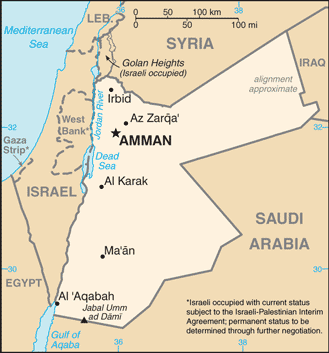Topics Covered
Welcome to Jordan
Overview of Resources
Industrial Minerals
Fossil Fuels
Investment
Sources
Welcome to Jordan
Jordan is one of the Middle East countries located to the northwest of Saudi Arabia, between Israel and Iraq. The total area of the country is 89,342 km2, and it has a population of 6,508,887 as of July 2012. The country experiences an arid desert climate.
 |
The national flag of Jordan.
Image Credit: CIA Factbook. |
Jordan has been a politically stable country, but in 2011, the country’s peace was disrupted as Jordanians conducted protest demonstrations around the country for better political reforms and for solutions to rising prices. In response to these protests, King Abdallah launched many new reforms, which has appeased many of the people to a certain extent. The global economic downturn and the internal upheaval have slowed down Jordan's GDP growth. The GDP of Jordan in 2011 was $37.37 billion. The country relies on foreign assistance, especially from the Gulf countries.
Jordan’s natural resources are very limited and include phosphates, potash, and shale oil. The mining sector does not play a significant role in its economy.
Overview of Resources
In 2010, Jordan produced significant amount of bromine and phosphate rock. It was ranked the sixth and seventh producer of phosphate rock and potash in the world, respectively.
Jordan also produced other mineral commodities in lesser quantities. These include cement, limestone, silica sand, fertilizer, clay, kaolin, pozzolanic material, refined petroleum products, steel, zeolitic tuff, and calcium carbonate.

The map of Jordan. Image Credit: CIA Factbook
Industrial Minerals
The majority of Jordan’s cement production was carried out by Jordan Lafarge Cement Factories Co. P.S.C. (JCFC) in 2010. JCFC operated two cement plants in the country.
The cement plant operated by Northern Cement Co. at Muwaqar began producing 1 Mt/yr of cement in 2009. This plant produced ordinary portland cement, sulfate-resistant cement, and pozzolan cement.
Several construction projects started in 2010. Arabian Cement Co. of Saudi Arabia completed the Qatrana cement plant at Al Qatraneh. The plant was designed to produce 1.8 Mt/yr cement. Jordan Abyad Fertilizers and Chemicals Co. P.S.C. (JAFCCO) completed the $90 million fertilizer manufacturing complex at the Aqaba Industrial Complex. It is likely that the project would increase Jordan’s diammonium phosphate production capacity from 650,000 t/yr to 1 Mt/yr in the coming years.
Similarly, a $640 million phosphoric and sulfuric acid complex owned by Jordan Indian Fertilizer Co. (JIFCO) was under construction at Eshidiya. JIFCO is a joint venture between Indian Farmers Fertilizers Cooperative of India (IFFCO) with 52% interest and Jordan Phosphate Mines Co. p.l.c. (JPMC) with 48%.
Jordan’s potash production increased in 2010 to about 1.9 Mt compared to 1.1 Mt in 2009. An expansion project by Arab Potash Company Ltd. (APC) helped to increase production capacity of potash to 2.45 Mt/yr from 2.0 Mt/yr.
Fossil Fuels
Throughout the 1990s, the government of Jordan was involved in conducting extensive exploration activities to locate uranium deposits. The exploration activities revealed that the country had good quantities of deposits. The official estimates of uranium ore and uranium procured from phosphate deposits amounted to 140,000 and 59,000 t, respectively.
The government planned to use the uranium to support nuclear technology, which could in turn be used to generate power and decrease the country’s imports of electricity and hydrocarbons.
In 2010, global company, Areva Group S.A. gained exclusive rights to explore and produce uranium for 25 years in the central region of Jordan. Areva along with Jordan Energy Resources Inc. created Jordanian French Uranium Mining Co. (JFUMC) to fulfill its uranium exploration mission. Early studies revealed that the Al-Hassa deposit contained about 65,000 t of proven uranium ore. Other companies that are showing keen interest in Jordan’s uranium are Australian Rio Tinto and the Chinese Sino Uranium.
In the same year, Jordan Atomic Energy Commission made a deal with Rio Tinto Alcan of Australia and UK to conduct exploration activities to locate uranium, zirconium, and thorium in Jordan.
According to the Jordanian Natural Resources Authority, phosphate formations are said to cover nearly 60% of the country’s total area.
Investment
In 2010, the government of Jordan focused on promoting investment for the development of its large shale oil reserves to aid production of crude oil. It also worked towards showcasing its large uranium deposits.
Experts state that the future of uranium ore sector in Jordan will depend on both the world’s requirement for nuclear power as well as on the government’s effort to attract foreign investment to fund its soon-to-be constructed nuclear power plants.
Jordan will also have to sort out its internal conflicts and provide better economic relief for its people to boost its mineral sector.
Disclaimer: The Author of this article does not imply any investment recommendation and some content is speculative in nature. The Author is not affiliated in any way with any companies mentioned and all statistical information is publically available.
Sources
Disclaimer: The views expressed here are those of the author expressed in their private capacity and do not necessarily represent the views of AZoM.com Limited T/A AZoNetwork the owner and operator of this website. This disclaimer forms part of the Terms and conditions of use of this website.